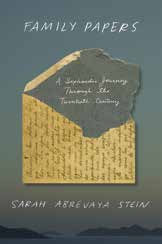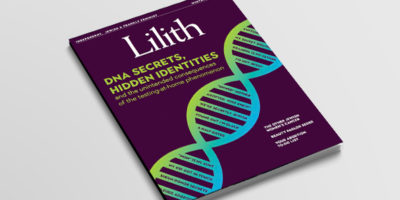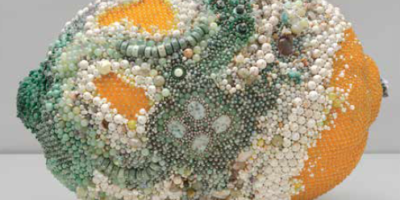
Trauma and Transition in Sephardic History

Family Papers: A Sephardic Journey Through the Twentieth Century ($28.00), a remarkable new book by Sarah Abrevaya Stein, introduces the lives and legacies of Salonica’s Jews during the nineteenth and twentieth centuries. Abrevaya Stein takes readers on an intimate multi-generational journey via the lives of Sa’adi Besalel Ashkenazi a-Levi (later Levy), a prominent publisher in nineteenth-century Salonica, his 14 children, and a number of their descendants. Her research into the Levy family includes interviews conducted across multiple continents, and a collection of documents such as letters, photographs, telegrams, and miscellaneous “family papers” written in over half a dozen languages, reflecting both the cosmopolitan and diasporic reality of the Levy family. These sources, available to the author as a co-editor and co-translator of Sa’adi’s original Ladino memoir, open up the world of the Levys and the radical changes they navigated over the course of their lives.
Organized chronologically, the book’s seven sections reflect the socio-political reality of the Levy family, and Sephardic Jews more broadly, the Jewishness of Salonica is palpable. Abrevaya Stein captures the vibrancy and possibilities of a thriving port city in the late nineteenth century in which there is “a Jewish plurality, if not a Jewish majority,” with Jews numbering between 60,000 and 100,000, and setting the pace for the city’s commercial life. It is against this vibrant landscape that Abrevaya Stein introduces Sa’adi’s children, observing their lives through a prism of the social and political realities of the time, and explores the multiple ethnic, national, and religious identities that informed Ottoman Jewry during this robust period of change. Within the tensions that arise from a society in flux, she makes these transformations personal.
Family Papers presents intimate vignettes which reveal the challenges between tradition and modernity, Ottoman political changes, and institutional forces, like the Alliance Israélite Universelle, which shaped the lives of many Ottoman Jews. For example, Sa’adi’s daughter Rachel, a “dutiful daughter of the Alliance…[and] travelled distances unimaginable to most Ottoman women of the time.” Rachel graduated Salonica’s Alliance school at age 15 or 16, then continued to Paris in 1877, where she continued her education and teacher training at the École Normale Israélite Orientale. Graduating at 18, she assumed a post in a poor Jewish neighborhood in Istanbul. She married Elie Carmona, another Alliance graduate, and they “would travel across the Levant in the employ of the Alliance, working as a teacher (Rachel) and a school director (Elie)” in Morocco, Beirut, Jerusalem, Bulgaria, and Macedonia. Through Rachel’s travels, readers are familiarized not only with the Alliance movement but also with how Rachel and Elie were affected by gender, modernity, and war. They struggled to feed their young daughter after they arrived in Tétouan in 1900 as famine and violence engulf the city due to civil war. Elie writes that the family’s “existence has become intolerable” as they attempted to flee, despite the Alliance’s directive to remain and aid the local poor. Throughout, Sa’adi’s children represent possibilities as well as challenges. One son, Sam, followed in the family business of newspapers and publishing; another, David/Daout became a “high-ranking official in Ottoman bureaucracy, and, in time, interwar head of Salonica’s Jewish community.” Though the book reflects the deep nostalgia of its protagonists, its author is careful not to romanticize the past. When she introduces us to Rachel, whose “education liberated her from the restrictions that had bound her mother’s generation,” she explains that as Rachel assumed a teaching position with the AIU that would take her throughout Ottoman world, she entered into “a new, equally patriarchal authority…and with it, the ideals of Western European bourgeoisie.” And later we learn that Sa’adi’s great grandson Vital was a Nazi collaborator known as “The Jews nightmare,” and he became “the only Jew in Europe tried as a war criminal and killed by a state, Greece, at the behest of its Jewish community.”
Family Papers moves readers through exciting and formidable junctures in Salonica’s history. The Levy family “had lived under Ottoman, Greek, German, French, Spanish, Portuguese, British, Indian and Brazilian rule.” Abrevaya Stein utilizes the “family papers” to illuminate loss, trauma, and transition. The First Balkan War, in 1912, had a dramatic impact on all the Jews of Salonica, because it resulted in the establishment of a Greek and Christian cityscape— Salonica is renamed Thessaloniki, streets are renamed for Greek heroes and figures, Jews are placed under particular labor restrictions and lose the ability to regulate the pace and culture of commercial life. Gone are the days where the port was closed on Saturday and open on Sunday, in deference to Jewish dock workers. This war, and the others that shape the lives of the Levy family, mean that Sephardic Jews like the Levys face questions of citizenship and belonging. The various wars also continue to bring to the fore the question of Zionism. The Levy family’s ambivalence about— and sometimes outright rejection of— Zionism illuminate not only a particular Ottoman identity, important to many Sephardic Jews of the period, but also indicates the Ashkenazi face of the movement. Sam, whose Jewish journalistic work is dismissed by Zionists, believes that the problem with Zionists is “that they tended to be ignorant of Sephardic culture, and history, and oblivious to the importance of Sephardic activism.”
The extensive destruction of Salonican Jewry is told through the profound loss that the Levy family confronts as they exchange letters in the years immediately following World War II. Abrevaya Stein writes, “Family history continued to matter, in diaspora and even in death.” By the conclusion of the Second World War, the Levy family, scattered through Europe, Latin America, and India, clamors for news of hope and survival amidst the rubble. Instead, they are met with tales of destruction and loss. By this point, Sa’adi’s far-flung descendants no longer speak Ladino, and many had never lived in Salonica, yet the “Jewish city” continued to be the center of family lore and identity. Family Papers reflects the possibilities of modernity, the richness of Ottoman Jewry, and the nostalgia of diaspora consciousness. Her deeply intimate portraits of the Levy family present “how this family loved and quarreled, struggled and succeeded, clung to one another and watched the ties that once bound them slip from their grasp.”
HILIT SUROWITZ-ISRAEL is a professor in the Religion Department at Rutgers University. She is co-author, with Laura Leibman and Michel Hoberman of Jews in the Americas, 1776–1826. She is currently completing American Diasporas: The Creolization of Religion in the Colonial Atlantic World.





